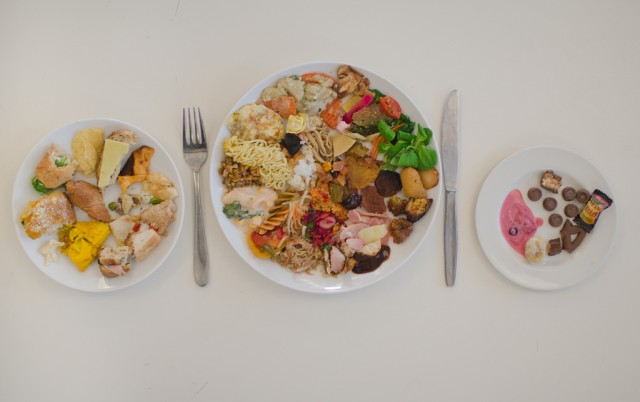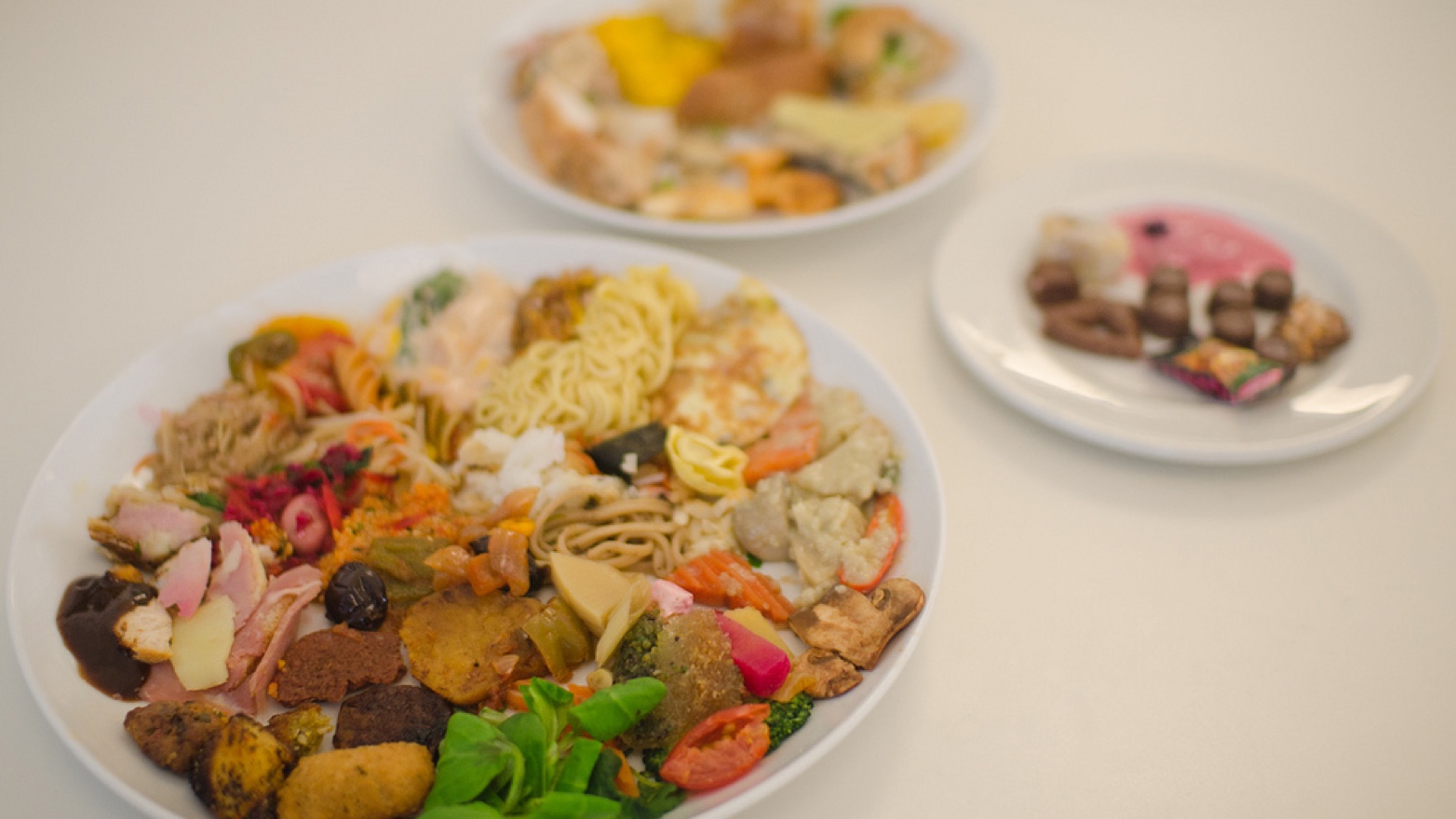Sam Hill
28th November 2011

It’s probably best to get the “Variety is the spice of life” axiom out of the way as soon as possible. But like most hackneyed phrases, it’s still observably true, and appropriately this is especially applicable with food. Meals are significant daily experiential events, and their consumption is analogous to other sensory stimulating activities.
The argument for this post is as follows: the difference in flavour between mouthfuls is arguably as important as the quality of flavours themselves.
It’s a contentious idea, perhaps. But can you imagine eating a piece of mackerel immediately after a mouthful of toffee? Or a slice of liver after a spoonful of banana ice-cream? Flavour combination is a science – hence The Flavour Thesaurus and Heston Blumenthal’s ‘Molecular Gastronomy’.
Choice and Variety
Most western cities afford their denizens a luxury of access – access to the world’s cuisine: Italian, Moroccan, Caribbean, Thai, Mexican, Polish, Chinese, Indian… there’s never been more choice. And yet, a meal will often take the same format – carb, meat, veg, sauce.
OK – Admittedly, that’s a little simplistic. Most cultures take an encouragable approach to variety – i.e. putting a lot of different things past your taste buds in one sitting. In France they have degustation; in Japan they have bento; in India they have thali; in Spain they have tapas; in the Mediterranean they have Meze; in Scandanavia they have Smörgåsbord. In the UK we have our classic Sunday Roasts with all the trimmings, and the occasional, colonically ambitious ‘mixed grill’.
‘The Überbuffet’

These kinds of meals are enormously satisfying, and the total amount consumed doesn’t need to be enormous. But what happens when we go further, take the idea to the logical conclusion and try to get as much variety into a meal as possible? In other words: should we propagate a hyper-varied überbuffet? After all, at any particular sitting, assuming an individual can consume only a finite amount of food, is there really any experiential benefit to eating the same kind of thing more than twice?
Experiential Analysis of the Eating Process
Eating foodstuffs follows a sort of narrative. It is a ritual, familiar and daily, with definable and discreet stages. The first bite allows a ‘consumer’ (in the most literal sense) to explore the taste and texture of a food. Between it and the second bite they have the memory of enjoying the first piece and the anticipation of the next. At the last bite, the now familiar flavours can be actively savoured. Between these milestones, any intermediary moments will lack the same level of concentration or awareness – so they are surplus to any experiential requirement. Therefore, it makes sense to pack as much into a meal as possible by using only pairs of each morsel.
An appreciation for food consumption as a designed experience can allow us to both maximise the sensory potential of our olfactory and taste receptors, and ensure we consume in a way that is sustainably healthy. A homogenous foodstuff can encourage rushed eating because a different reward mechanism to taste is employed – the dopamine release from binging. This in turn is likely to cause over-eating, because the body’s appetite-feedback system is not immediate. If food is consumed at a controlled rate with appreciation for its flavour being the primary reward, then the body is likely to feel full before eating too much. This controlling of pace can be achieved through careful experiential design, and in this case using a greater variety of flavour in smaller quantities is a suggested design solution.
There’s nothing too revolutionary here. The slow food movement has been making a point of promoting Taste Education for decades, and it’s been a while since hypnotherapist Paul McKenna began recommending to aspiring weight-losers to chew mouthfuls 20 times.
Summary
From an experience designer’s point of view especially, the value of variety deserves a little respect. Though the focus here is on food, the applications are global. The intensity of an experience is bound by context because it is relativistic – we don’t have absolute values or experiential calculus to quantify with (not yet anyway). To talk about events, or objects in any meaningful way we have to draw comparisons with what we already know and use phrases like ‘better than’, ‘worse than’ and ‘different to’. Hence, successive differences are what we use to make sense of what there is, what there was, and what there will be.
(Thankyou to Goldsmith’s first-year BA Design students for helping compile the meal featured in the above images)
Appendix I: Experiential Counter-Arguments
This proposition is not without its’ criticisms, even from a pro-experiential view point. Here are some counter arguments, with their criticisms addressed.
– “Two mouthfuls are not enough – it takes longer to “get into” something.”
On the first hand, this might be a conditioned belief. Perhaps some do not “get into” a meal until after a few bites because it isn’t necessary to do so. If placed within a context where flavour needs to be savoured, then new behaviours would be learnt.
Secondly, this criticism might be based on a misunderstanding. The claim is not that two mouthfuls of a meal are more experientially rich than a dozen mouthfuls of the same thing, as this is clearly not the case. Rather, all intermediary mouthfuls are much less rich than the first and last. The true argument is that six pairs of flavoured mouthfuls are experientially richer than one flavour repeated 12 times.
– “I’d rather have a different meal every day, than an überbuffet every single day.”
This is an interesting point – macro-variety is as important as micro-variety. But the premise of this criticism is that the two cannot exist together. Bento on a Monday followed by thali on a Tuesday followed by meze on a Wednesday does not make for generic consumption, certainly no more generic than the overarching typology of what a “meal” is. In actual fact, adding more options to a plate increases the uniqueness of each potential meal by an exponential magnitude – having more combinations of flavours, textures and smells to play with would ensure you need never have the same plate of food twice.
– “I don’t really like X, I much prefer Y. Why would I have a bit of X, when I could just have more Y instead?”
The aim here is not to increase pleasure of consumption per se, though that would hopefully be an incentivising by-product. The aim is, instead, to increase the experiential value of a meal. For a distinction between the two, and an overview of experiential value have a look at this.
But secondary to that, it is hoped that the variety of flavours, not just the flavours themselves could become something to relish and enjoy.
– “Aren’t flavour clashes more likely on a plate with more variety?”
Yes, it is likely that some flavours will clash horribly. TV chefs have been known to criticise a meal for having “too much going on”. A ‘Pure experientialist’ might accept this as part and parcel of the eating experience. A more conventional ‘hedonic-experientialist’ (full definition pending) could choose to employ the use of sorbets or other pallet cleansers, learn something about the theory of flavour combinations when preparing their own food or perhaps defer to an expert to advise on or prepare meals.
– “Preparing more complex, varied meals can be costly and time consuming. Couldn’t the time and money invested in preparing an Überbuffet be better spent doing other, more experiential, things?”
To prepare a meal from scratch with so many component foodstuffs will take a long time, and that time could be spent doing other things, so the decision to do so may come down to a personal preference. Some people get a lot more out of cooking than others.
Perhaps the most effective way to counter this is with scales of production, which, granted, has it’s own host of problems. A restaurant can more capably prepare a number of complex dishes than someone at home, but eating out is expensive. A supermarket could supply complex ready-made meals prepared in factories but the quality of preparation and ingredients can be questionable. The compromise between quality and quantity of flavours is debatable.
One option might be to encourage communal eating – i.e. people meet in large groups having prepared one dish each, then the portions are distributed evenly.
– “The experience of food should go beyond the plate. I enjoy food because I’ve prepared or grown it myself.”
This is another good point. Some people find a lot of satisfaction in the context by which they come by their food. It’s harder to achieve a broad variety solely through one’s own means, though not impossible.
– “This idea is too prescriptive. People should be able to eat however they choose.”
Absolutely, this is just a didactic suggestion for experiential enrichment, not sensory dogma.
Appendix II: Value Conflicts
As is often the case, attempting to better satisfy one value system will dissatisfy another. Though experiential richness might in some respects be beneficial to one’s health, there will be a clash with other ideals.
Other Health Issues
Practically, to have more variety might require foods have a longer lifespan. If this was the case, preservable foods might be favoured over fresh ingredients, like fruit and veg and unprocessed meat.
Ecology
Perhaps through well organised systems the effects could be marginalised, but it’s likely that a hyper-varied diet would be less sustainable. To get more choice means looking beyond local resources and forming a more complex logistical web; smaller portions and partitioned containers might mean more packaging.
Cost
Varied meals would almost certainly be more expensive to produce. The cost of a varied-consumption lifestyle would likely be higher, and so less attainable for everyone. This might exacerbate a stratification of experience wealth – a split between those that have variety and those that do not.





